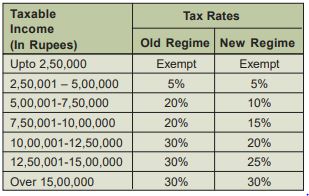India gives its citizens a choice of two tax regimes. Whether you choose the old tax regime or the new one should depend on your annual income, income structure and selection of investments.
The new tax regime was introduced in 2020 by the Government of India with more slabs and lower tax rates. However, it did not do away with the old tax regime.
Instead, taxpayers can choose between the two regimes, depending on what works best for them. New Vs old tax regime Taxpayers in India have to file their taxes depending on the different tax slabs they fall into. The significant difference between the new and old tax regimes is in the number of income tax slab rates. The new regime has more tax slabs with relatively lower tax rates. Here’s a comparison between the two:

There is another difference between the two regimes that is important to consider. The old tax regime allows for about 70 deductions and exemptions that taxpayers can use to reduce their tax liability. There are different investment options and certain expenses, such as payment of insurance premiums that reduce taxable income. Salaried individuals can also claim a standard deduction of Rs.50,000. The new tax regime has done away with most of these deductions. However, there are some deductions that are still permissible under the new tax regime. These include:
• Post Office Savings Account interest of up to Rs. 3,500 for single accounts and up to Rs. 7,000 for joint accounts
• Employer gratuity up to Rs. 20,00,000
• Maturity amount and income from life insurance policies
• Employer contribution to NPS and EPF
• Any income from agricultural
• Standard rent deduction
• Retrenchment compensation
• Retirement leave encashment
• Proceeds from Voluntary Retirement Scheme of up to Rs. 5,00,000
• Scholarship for education
• Maturity and interest from PPF or Sukanya Samriddhi Yojna
• Commutation of Pension / Payment received from NPS
Which regime should you choose?
Choosing between the two regimes comes down to the annual taxable income, whether you are a salaried or a self-employed individual and your investment preferences and plans. The new regime is beneficial for those with lower income tax slab rates. It also gives taxpayers the freedom to choose what investments they want to make. It does not force you to lock in investments in tax-saving instruments.
However, if you are in the higher tax bracket and have eligible investments / expenses / payments, you can benefit from the exemptions and deductions, the old tax regime offers. If you are a salaried person, you can claim a standard deduction. You can also claim deductions of up to Rs. 1,50,000 under Section 80C of the Income Tax Act if you invest in specific tax-saving instruments.
Some prominent Tax saving sections and the limits p.a:
• Section 80C: Covers investments made in instruments such as ELSS, PPF, expenses like tuition fees paid, repayment of home loan principal, payment of life insurance premium, etc. has a limit of Rs.1,50,000.
• Section 80D: Health Insurance Premium Limits: Rs.25,000 + Rs.25,000 (self & parents are <60 Yrs age); Rs.50,000 + Rs.50,000 (self & parents are >60 Yrs age).
• Section 80CCD(1B): New Pension Scheme. Limit: Rs.50,000.
• Section 24: Interest payment on home loan, upto Rs.2,00,000 (also there are affordable housing loans with separate limits subject to conditions).
In addition to the above, there are few other exemptions / allowances which are available for claiming as deduction in the old tax regime.

As mention in the table on difference in tax liabilities for different levels of income when choosing between the new and old tax regimes, if one has deduction and exemptions exceeding 2,50,000, old tax regime is beneficial.
Can you switch between the two regimes?
As a salaried individual, you can choose which regime you want to pick every year. However, individuals who file their taxes under the Business and Profession category get the chance to select the new tax regime only once. After that, if they switch back to the old tax regime, they have to stick to it.
While choosing between the new and old tax regimes, you should ideally compute the tax liability under both regimes and see which one is more beneficial. There are many tax calculators available in the market to compare the two. You can also bank on professional advice from experts, such as Geojit, to choose a suitable tax regime.






